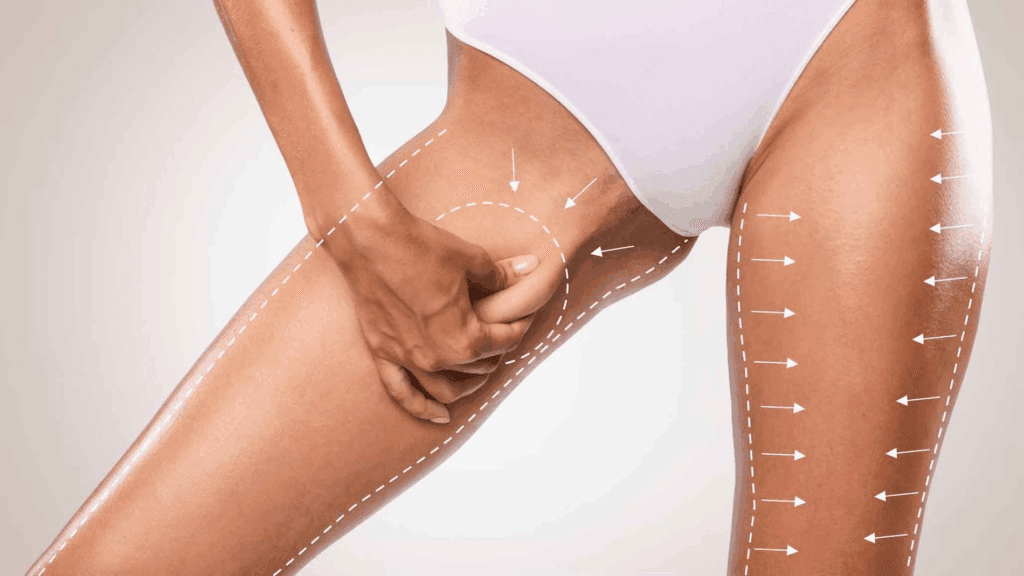Considering a thigh lift but worried about the scars? You’re not alone. Thighplasty surgery can transform the appearance of your thighs by removing excess skin and fat, but it inevitably leaves scars. Understanding the types of scars you can expect, their healing process, and how to minimize their appearance is crucial for setting realistic expectations and achieving the best possible results.
In this comprehensive guide, we’ll explore:
- ال types of scars you can expect after thighplasty.
- ال healing timeline for thighplasty scars.
- Effective strategies to minimize scar visibility.
- Medical treatments and procedures for scar reduction.
- Lifestyle tips to support optimal healing and scar management.
By the end of this guide, you’ll have a clear understanding of what to expect from thighplasty scars and how to care for them to achieve the best possible outcome. Let’s dive in!

جدول المحتويات
1. Types of Scars After Thighplasty
1.1. Linear Scars
Linear scars are the most common type of scars resulting from thighplasty surgery. These scars follow the incision lines made during the procedure and can vary in length depending on the type of thigh lift performed.
| وجه | وصف | موقع |
|---|---|---|
| Appearance | Thin, straight lines that initially appear red or pink and gradually fade to a lighter color. | Along the groin crease, inner thigh, or outer thigh, depending on the procedure type. |
| Healing Process | Typically takes 12-18 months to mature and fade. Initially raised and red, they flatten and lighten over time. | Follows the incision lines made during surgery. |
| Minimization | Can be minimized with proper wound care, silicone sheets, and laser treatments. | Consistent scar care is essential for optimal results. |
1.2. Hypertrophic Scars
Hypertrophic scars are raised, red, and thickened scars that remain within the boundaries of the original incision. They are more common in individuals with darker skin tones and can be itchy or uncomfortable.
| وجه | وصف | Management |
|---|---|---|
| Appearance | Raised, thick, and red scars that do not extend beyond the incision site. | Often appears within the first few months post-surgery. |
| Causes | Result from an overproduction of collagen during the healing process. | More common in individuals with darker skin or a genetic predisposition. |
| علاج | Steroid injections, silicone gel sheets, or laser therapy can help reduce their appearance. | Early intervention is key for effective management. |
1.3. Keloid Scars
Keloid scars are an aggressive form of hypertrophic scarring that extend beyond the original incision site. They can be large, raised, and dark in color, and may continue to grow over time.
| وجه | وصف | Management |
|---|---|---|
| Appearance | Large, raised, and dark scars that extend beyond the incision boundaries. | Can be itchy, tender, or painful. |
| Causes | Result from an overactive healing process and excessive collagen production. | More common in individuals with darker skin tones or a family history of keloids. |
| علاج | Steroid injections, radiation therapy, surgical excision, or laser treatments. | Early and aggressive treatment is necessary to prevent growth. |
1.4. Stretch Marks and Scar Combinations
In some cases, existing stretch marks may be removed or altered during thighplasty, but new scars will form along the incision lines. The combination of scars and residual stretch marks can affect the overall appearance of the thighs.
| وجه | وصف | Management |
|---|---|---|
| Appearance | Combination of linear scars from surgery and existing or new stretch marks. | May appear as a mix of thin lines and wider, discolored areas. |
| Causes | Result from the removal of excess skin and underlying stretch marks during surgery. | New stretch marks may form if the skin is stretched post-surgery. |
| علاج | Topical creams, laser therapy, and microneedling can improve appearance. | Consistent skin care and maintaining a stable weight are crucial. |
Pro Tip: Discuss your scar history and skin type with your surgeon during the consultation. This will help them tailor the procedure and post-op care to minimize scarring based on your individual needs.

2. Healing Timeline for Thighplasty Scars
2.1. Immediate Post-Op Period (First 2 Weeks)
The first two weeks after thighplasty are critical for initial wound healing. Proper care during this period can significantly impact the final appearance of your scars.
| Stage | What to Expect | Care Tips |
|---|---|---|
| First 48 Hours | Incisions will be covered with dressings, and there may be drainage tubes in place. Swelling, bruising, and discomfort are common. | Follow your surgeon’s instructions for wound care, keep incisions clean and dry, and avoid straining the area. |
| Days 3-7 | Dressings may be changed, and stitches or staples may start to dissolve or be removed. Scars will appear red and slightly raised. | Continue following wound care instructions, avoid soaking incisions, and wear compression garments as directed. |
| Days 8-14 | Swelling and bruising begin to subside. Scars may start to itch as they heal. Mobility improves, but strenuous activities should still be avoided. | Apply silicone gel sheets or recommended ointments, and keep incisions moisturized to reduce itching. |
2.2. Intermediate Healing (Weeks 3-12)
During the intermediate healing phase, scars begin to mature and fade. Consistent care is essential for optimal results.
| Stage | What to Expect | Care Tips |
|---|---|---|
| Weeks 3-6 | Scars become less red and start to flatten. Itching and tightness may persist as the skin continues to heal. | Continue using silicone sheets or gels, and gently massage scars to improve flexibility and reduce tightness. |
| Weeks 7-12 | Scars continue to fade and soften. They may still be slightly raised or discolored but will gradually blend with surrounding skin. | Use sunscreen to protect scars from UV exposure, which can darken them. Consider laser therapy or microneedling for further improvement. |
2.3. Long-Term Healing (Months 6-18)
In the long-term healing phase, scars mature and become less noticeable. Patience and consistent care are key during this period.
| Stage | What to Expect | Care Tips |
|---|---|---|
| Months 6-12 | Scars become lighter, flatter, and less noticeable. They may still be slightly visible but will continue to improve. | Continue using scar treatments as recommended. Consider professional treatments like laser therapy for stubborn scars. |
| Months 12-18 | Scars reach their final appearance, which is typically a thin, faint line. They may never completely disappear but will be significantly less noticeable. | Maintain a healthy lifestyle and skin care routine to preserve results. Discuss any concerns with your surgeon. |
Pro Tip: Keep a healing journal to track the progress of your scars. Take photos at regular intervals to monitor changes and discuss any concerns with your surgeon during follow-up appointments.
3. Strategies to Minimize Thighplasty Scars
3.1. Pre-Surgery Preparation
Proper preparation before thighplasty surgery can help minimize scarring and support optimal healing.
| Preparation Step | Why It Matters | Tips |
|---|---|---|
| Nutrition | A balanced diet rich in vitamins and minerals supports skin health and healing. | Focus on foods high in vitamin C, zinc, and protein to promote collagen production and tissue repair. |
| Hydration | Proper hydration keeps skin supple and aids in the healing process. | Drink at least 8 glasses of water daily and avoid dehydrating beverages like alcohol and caffeine. |
| الإقلاع عن التدخين | Smoking impairs healing and increases the risk of poor scarring. | Quit smoking at least 6 weeks before and after surgery to improve healing and minimize scars. |
| Skin Care | Healthy skin is more resilient and heals better post-surgery. | Use moisturizers and avoid harsh skin treatments before surgery. Discuss pre-op skin care with your surgeon. |
| Medical Evaluation | Ensures you are in optimal health for surgery and healing. | Undergo a thorough medical evaluation and address any underlying health issues before surgery. |
3.2. Post-Surgery Scar Care
Effective post-surgery scar care is crucial for minimizing the appearance of thighplasty scars. Follow these strategies for optimal results:
| Strategy | Why It Matters | Tips |
|---|---|---|
| Silicone Gel Sheets | Silicone sheets help hydrate the scar, reduce redness, and flatten raised scars. | Apply silicone sheets as directed by your surgeon, typically for several hours a day. |
| Topical Ointments | Ointments like petroleum jelly or specialized scar creams keep the scar moisturized and promote healing. | Use recommended ointments consistently, especially during the first few months of healing. |
| Scar Massage | Gentle massage improves blood circulation, softens scars, and reduces tightness. | Massage scars in circular motions for a few minutes daily once incisions are fully closed. |
| الحماية من الشمس | UV exposure can darken scars and make them more noticeable. | Apply broad-spectrum sunscreen (SPF 30 or higher) to scars whenever they are exposed to sunlight. |
| الملابس الضاغطة | Compression helps reduce swelling and supports the healing process. | Wear compression garments as instructed by your surgeon, typically for several weeks post-op. |
3.3. Medical Treatments for Scar Reduction
Several medical treatments can further minimize the appearance of thighplasty scars. Discuss these options with your surgeon:
| علاج | وصف | Considerations |
|---|---|---|
| Laser Therapy | Laser treatments can reduce redness, flatten raised scars, and improve overall appearance. | Multiple sessions may be required. Discuss with your surgeon to determine the best type of laser for your scars. |
| Steroid Injections | Corticosteroid injections help reduce inflammation and flatten hypertrophic or keloid scars. | Typically used for more severe scarring. May require multiple sessions. |
| Microneedling | Microneedling stimulates collagen production and improves the texture and appearance of scars. | Can be combined with topical treatments for enhanced results. Requires multiple sessions. |
| Scar Revision Surgery | Surgical revision can improve the appearance of wide or irregular scars. | Considered only after scars have fully matured, typically at least 12 months post-op. |
| Chemical Peels | Chemical peels exfoliate the skin and promote the growth of new, healthier skin cells. | Best for superficial scars and discoloration. Discuss suitability with your surgeon. |
Pro Tip: Start scar care treatments as soon as your surgeon approves, typically once incisions are fully closed. Early intervention can significantly improve the final appearance of your scars.

4. Lifestyle Tips for Optimal Scar Healing
4.1. Nutrition for Scar Healing
A balanced diet rich in essential nutrients supports skin healing and minimizes scarring. Focus on the following nutrients:
| Nutrient | Role in Healing | Food Sources |
|---|---|---|
| Vitamin C | Supports collagen production and tissue repair. | Citrus fruits, strawberries, bell peppers, broccoli. |
| Zinc | Promotes wound healing and immune function. | Lean meats, seafood, nuts, seeds, legumes. |
| Protein | Essential for tissue repair and regeneration. | Chicken, fish, eggs, dairy, tofu, lentils. |
| Vitamin A | Supports skin health and immune function. | Sweet potatoes, carrots, spinach, kale. |
| Vitamin E | Acts as an antioxidant and supports skin health. | Almonds, sunflower seeds, avocados, spinach. |
4.2. Hydration and Skin Health
Proper hydration is essential for maintaining skin elasticity and supporting the healing process. Follow these tips:
| Tip | Why It Matters | Implementation |
|---|---|---|
| Drink Plenty of Water | Keeps skin hydrated and supports overall healing. | Drink at least 8 glasses of water daily. |
| Avoid Dehydrating Beverages | Alcohol and caffeine can dehydrate the skin and impair healing. | Limit intake of alcohol and caffeinated beverages. |
| Use Moisturizers | Moisturized skin is more elastic and heals better. | Apply a gentle, fragrance-free moisturizer to scars and surrounding skin. |
| Humidify Your Environment | Dry air can dehydrate the skin and slow healing. | Use a humidifier in your home, especially in dry climates. |
4.3. Exercise and Activity Guidelines
Following appropriate exercise and activity guidelines supports healing and minimizes the risk of complicating scars:
| Guideline | Why It Matters | Implementation |
|---|---|---|
| Avoid Strenuous Activity | Strenuous activity can strain incisions and worsen scarring. | Follow your surgeon’s guidelines for resuming physical activity, typically avoiding heavy lifting and intense exercise for 4-6 weeks. |
| Gradual Return to Exercise | Gradual reintroduction of exercise supports healing without overstressing scars. | Start with light activities like walking and gradually increase intensity as approved by your surgeon. |
| Wear Compression Garments | Compression supports healing and reduces swelling. | Wear compression garments as directed, typically for several weeks post-op. |
| Avoid Direct Sun Exposure | UV rays can darken scars and make them more noticeable. | Protect scars from the sun with clothing or sunscreen (SPF 30 or higher). |
Pro Tip: Maintain a healthy lifestyle with a balanced diet, proper hydration, and regular, gentle exercise to support optimal healing and minimize scarring.
Conclusion: Key Takeaways for Managing Thighplasty Scars
Key Takeaways
- Types of scars after thighplasty include linear, hypertrophic, keloid, and stretch mark combinations. Understanding these types helps in managing expectations and care.
- ال healing timeline for thighplasty scars spans from immediate post-op care to long-term maturation, taking up to 18 months for scars to fully fade.
- Minimizing scars involves pre-surgery preparation, post-op scar care, and medical treatments like silicone sheets, laser therapy, and steroid injections.
- Lifestyle factors, including nutrition, hydration, and appropriate exercise, play a significant role in optimal scar healing and overall recovery.
Next Steps
Ready to take control of your thighplasty scar management? Here’s what you can do next:
- Consult with Your Surgeon: Discuss your scar history and concerns during your consultation to tailor the procedure and post-op care.
- Prepare for Surgery: Follow pre-surgery guidelines, including nutrition, hydration, and smoking cessation, to support optimal healing.
- Follow Post-Op Care Instructions: Adhere to your surgeon’s wound care and scar management recommendations for the best results.
- Explore Medical Treatments: Discuss advanced scar reduction treatments like laser therapy or microneedling with your surgeon.
- Visit فريق الجراحة: Connect with qualified surgeons and access expert guidance for your thighplasty journey.
في فريق الجراحة, we’re dedicated to helping you achieve your aesthetic goals safely and effectively. Contact us today to explore your options and take the first step toward a more confident you!
الأسئلة الشائعة
1. What kind of scars can I expect after thighplasty?
After thighplasty, you can expect linear scars along the incision lines, which may be hypertrophic (raised) or keloid (extended beyond the incision) in some cases. Existing stretch marks may also be affected.
2. How long does it take for thighplasty scars to fade?
Thighplasty scars typically take 12-18 months to fully mature and fade. They will gradually become lighter, flatter, and less noticeable over time.
3. Can thighplasty scars be completely removed?
While scars cannot be completely removed, their appearance can be significantly minimized with proper care, medical treatments, and time. Most scars fade to thin, faint lines.
4. What can I do to minimize thighplasty scars?
To minimize scars:
- Follow your surgeon’s pre- and post-op care instructions.
- Use silicone gel sheets or recommended ointments.
- Protect scars from sun exposure with sunscreen.
- Consider medical treatments like laser therapy or microneedling.
5. Are there any treatments to improve the appearance of thighplasty scars?
Yes, several treatments can improve scar appearance:
- Laser therapy to reduce redness and flatten scars.
- Steroid injections for hypertrophic or keloid scars.
- Microneedling to stimulate collagen and improve texture.
- Scar revision surgery for wide or irregular scars.
6. When can I start using scar treatments after thighplasty?
You can typically start using scar treatments once your incisions are fully closed, usually around 2-4 weeks post-surgery. Follow your surgeon’s specific recommendations.
7. How can I prevent keloid scars after thighplasty?
To prevent keloid scars:
- Discuss your scar history with your surgeon before the procedure.
- Follow all post-op care instructions diligently.
- Use silicone sheets or gels as recommended.
- Consider steroid injections if you are prone to keloids.
8. Will my thighplasty scars be visible in swimwear or shorts?
The visibility of thighplasty scars depends on their location and how well they fade. Medial thigh lift scars are often hidden in the groin crease, while lateral thigh lift scars may be more visible. Proper scar care can minimize their appearance over time.
Our Surgeons and Affiliated Professionals
في Surgyteam، نحن فخورون بالتعاون مع فريق متميز من المتخصصين الطبيين، حيث يتمتع كل منهم بخبرة واسعة والتزام بالرعاية التي تركز على المريض.
- د. محمد فاتح أوكياي (دكتور في جراحة التجميل والترميم): أخصائي جراحة التجميل والترميم. مؤسس مشارك في Surgyteam. حاصل على شهادة FEBOPRAS.https://www.dr-mfo.com/)
- د. سلجوق يلماز: أخصائي جراحة التجميل والترميم والتجميل.https://drselcukyilmaz.com)
- الدكتور إبرو أوكياي: أخصائي الأمراض الجلدية. (https://drebruokyay.com/)
- د. مصطفى كلش: أخصائي جراحة التجميل والترميم والبلاستيك.https://www.medstar.com.tr/doktorlar/mustafa-keles/)
- الدكتور بوراي يوسيل: أخصائي جراحة التجميل والترميم والتجميل.https://borayucel.com/)
- د. سيبل أتالاي: أخصائية جراحة التجميل والترميم والتجميل. عيادة حاصلة على ترخيص السياحة الصحية الدولية.https://www.sibelatalay.com.tr/)
- د. ميرت ميرال: أخصائي جراحة التجميل والترميم والتجميل. حاصل على شهادة EBOPRAS.https://mertmeral.com/)
لمعرفة المزيد عن Surgyteam وكيف يمكننا مساعدتك، يرجى زيارة موقعنا الإلكتروني:
https://surgyteam.com/
إخلاء مسؤولية: هذه التدوينة لأغراض إعلامية فقط، ولا تُعدّ نصيحة طبية. التكاليف تقديرية وقابلة للتغيير. استشر دائمًا طبيبًا مؤهلًا للحصول على نصائح وعلاجات شخصية.



